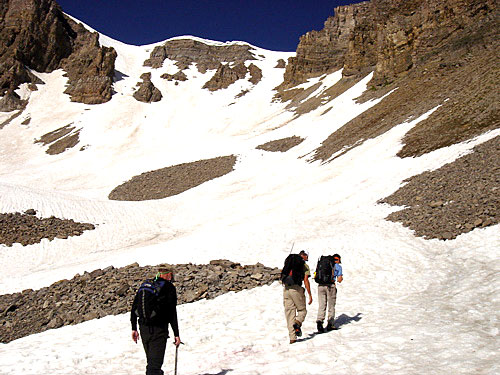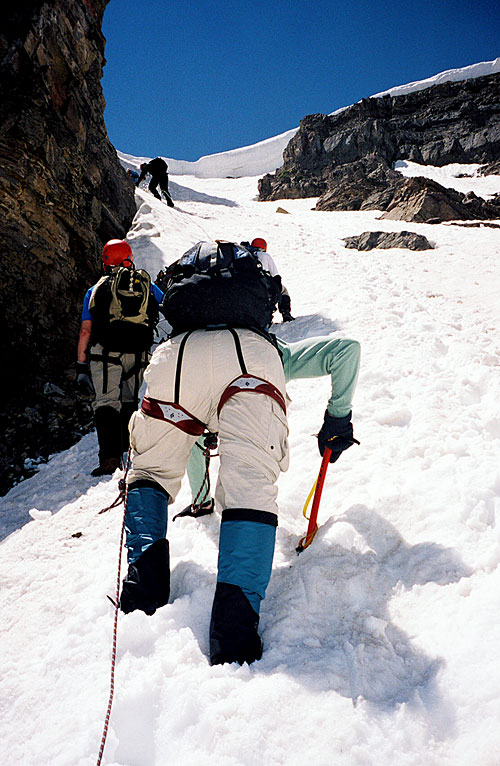
|
Hiking and climbing on snow requires practice and training for safety. Tuesday, July 5 Our guides, Mark Newcomb and Christian Santelices, both 38, met us at 7:45 a.m. at the Teton Village ski tram. Christian has been a guide for 16 years, and he's on the Nike ACG footwear and apparel design advisory board. He's a professional Nike ACG athlete. He holds a BA in anthropology from the University of California at Berkeley and an MA in Environment and Community. Mark grew up in Jackson Hole, where his father was a mountain guide. He's been guiding for 15 years. Mark has worked as a professional athlete for the Marmot outdoor apparel line for eight years. He writes Marmot's catalog and serves as design team leader. Here's what Christian said about Mark: “Mark has done numerous trips to the Himalaya, especially the Chinese side. Apart from that, he is one of North America's premier ski mountaineers. He's done first descents all over the Tetons, Alaska, and the Himalaya.” A ski mountaineer is a person who climbs mountains, often carrying skies on his back, and then skies down the most terrifying cliffs. It is a sport that appears to the uninitiated to be just plain crazy.
Here's what Mark said about Christian: “Christian, being a California boy, mostly rock climbed, especially in Yosemite. He took to big wall climbing, and he's done numerous first ascents on peaks in Torres Del Paine, where horrendous weather requires bold and fast climbing. He enjoys working with kids and has formed his own non-profit, the Global Community Project, to take kids to mountainous areas of the world to trek.” Beyond being excellent guides, they were articulate, socially and environmentally conscious, ambitious and good companions. Our program that first day, the guides explained, was to get comfortable climbing in snow and ice. We disembarked from the tram and headed off on foot to the foot of Cody Peak - elevation 11,010 feet. There is quite a bit to know about snow climbing, as it turns out. These long, sloping snowfields and couloirs can be dangerous. If a climber slips on a steep bank, he gathers speed rapidly in descent. Soon, it's impossible to stop. Mark and Christian began by showing us the proper technique for walking in snow. They showed us how to use the ice axes to self-belay or secure our position. “You'll notice,” Christian said, “I'm moving slowly but steadily. Here's the motto - go slow to go far. Your movements at these altitudes should be slow, deliberate and rhythmic. Don't even try for speed - establish a steady, slow rhythm as you walk. You'll be surprised how much ground you'll cover.” Higher up the steep, snow-covered embankment, Mark and Christian taught us to use our ice axes to self-arrest when falling. They stressed safety throughout the school and the climbs that followed. The object seemed not to teach us how to climb but to climb safely. Our last major bit of instruction that day was in the art of belaying a climber. In this exercise, a climber above secures and retrieves the rope attached to a climber below. As we were to learn, this is more than just a safety routine. We spent the rest of that day in a series of pitches up the steep snow bank we'd been climbing all afternoon. This climb up a steep snow embankment - 40 to 45 degrees - was slow and tedious, and it left us breathless in the thin air. Though surrounded by snow, the air temperature was in the sixties, and climbing in the snow was hot work. Finally, we broke over the top of the couloir past an overhanging lip of snow. That left us on the ridgeline to the top of the peak with just a few hundred yards to go. The worst part of that first day was the long walk down from the peak along the ridgeline and then back up a long, steep incline to the tram. We were very tired, and the ridgeline was strewn with heavy boulders. We had our first experience stepping from boulder to boulder while dead tired. The object, besides locomotion, was to avoid breaking a leg. As we rode the tram back to the base of the mountains, someone spotted a moose in the woods below us. I was too tired to move and look for it. |
By Dolph Tillotson
Climbing Teton
1 - Just Have Fun
2 - The Climbers
3 - Tuesday
4 - Wednesday
5 - Thursday
6 - Friday
7 - Summit Day 8 - Time is Short The relationships are more important than the climb. Resources See also |
© 2005 The Galveston County Daily News. All rights reserved. A Galveston Newspapers Inc. Publication. |


